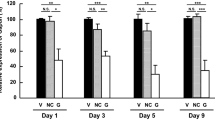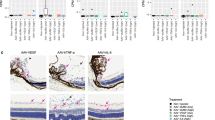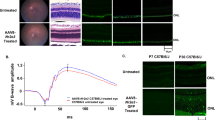Abstract
The eye is a relatively isolated tissue compartment, which provides advantages for utilization of small interfering RNA (siRNA). Feasibility of using siRNA for treatment of choroidal neovascularization has been demonstrated using siRNA directed against vascular endothelial growth factor (VEGF) or VEGF receptor 1 (VEGFR1), and both of these approaches are being tested in clinical trials. The results with VEGFR1 siRNA show that VEGFR1 is proangiogenic in the eye and is not a decoy receptor as it is in developmental angiogenesis. Topical delivery of siRNAs directed against VEGF or its receptors has also been shown to suppress corneal neovascularization. Signaling through transforming growth factor-β receptor 2 (TGFβR2) has been implicated in excessive ocular scarring and TGFβR2 siRNA has shown benefit in a model relevant to excessive scarring after glaucoma filtration surgery. RNAi has been used to identify genes that promote apoptosis or oxidative damage in retinal cells and could be the basis of new treatments for glaucoma or photoreceptor degenerations. In cultured cells derived from ocular tissues, siRNA has become a valuable tool to explore the potential role of various genes in ocular disease processes. Based upon this early experience in vivo and in vitro, it appears that siRNAs may be valuable to help define the pathogenesis and develop new treatments for several ocular diseases.
This is a preview of subscription content, access via your institution
Access options
Subscribe to this journal
Receive 12 print issues and online access
$259.00 per year
only $21.58 per issue
Buy this article
- Purchase on Springer Link
- Instant access to full article PDF
Prices may be subject to local taxes which are calculated during checkout
Similar content being viewed by others
References
Shen J, Samul R, Lima e Silva R, Akiyama H, Liu H, Saishin Y et al. Suppression of ocular neovascularization with siRNA targeting VEGF receptor 1. Gene Therapy [E-pub ahead of print, 29 September 2005; doi:10.1038/sj.gt.3302641].
Campochiaro PA . Retinal and choroidal neovascularization. J Cell Physiol 2000; 184: 301–310.
Klein R, Klein BEK, Linton KP . The Beaver Dam Eye Study: the relation of age-related maculopathy to smoking. Am J Epidemiol 1993; 137: 190–200.
Klein R, Klein BEK, Moss SE, Davis MD, DeMets, DL . The Wisconsin Epidemiologic Study of Diabetic Retinopathy. II. Prevalence and risk of diabetic retinopathy when age at diagnosis is less than 30 years. Arch Ophthalmol 1984; 102: 520–526.
Kwak N, Okamoto N, Wood JM, Campochiaro PA . VEGF is an important stimulator in a model of choroidal neovascularization. Invest Ophthalmol Vis Sci 2000; 41: 3158–3164.
Saishin Y, Saishin Y, Takahashi K, Lima Silva R, Hylton D, Rudge JJWS et al. VEGF-TRAPR1R2 suppresses choroidal neovascularization and VEGF-induced breakdown of the blood-retinal barrier. J Cell Physiol 2003; 195: 241–248.
Kryzstolik MG, Afshari MA, Adamis AP, Gaudreault J, Gragoudas ES, Michaud NM et al. Prevention of experimental choroidal neovascularization with intravitreal anti-vascular endothelial growth factor antibody fragment. Arch Ophthalmol 2002; 120: 338–346.
Reich SJ, Fosnot J, Kuroki A, Tang W, Yang X, Maguire AM et al. Small interfering RNA (siRNA) targeting VEGF effectively inhibits ocular neovascularization in a mouse model. Mol Vis 2003; 9: 210–216.
Tobe T, Ortega S, Luna JD, Ozaki H, Okamoto N, Derevjanik N et al. Targeted disruption of the FGF2 gene does not prevent choroidal neovascularization in a murine model. Am J Pathol 1998; 153: 1641–1646.
Tolentino MJ, Brucker AJ, Fosnot J, Ying GS, Wu IH, Malik G et al. Intravitreal injection of vascular endothelial growth factor small interfering RNA inhibits growth and leakage in a nonhuman primate, laser-induced model of choroidal neovascularization. Retina 2004; 24: 51–56.
Tolentino MJ, Brucker AJ, Fosnot J, Ying G, Wu IH, Malik G et al. Erratum. Retina 2004; 24: 660.
Tolentino MJ, Brucker A, Wan S, Reich SJ, Gordon J, Duh YJ . Letter to the Editor. Retina 2004; 24: 661.
Maguire M, Fine SL, Ying GS . Intravitreal injection of VEGF siRNA. Retina 2005; 25: 101–102.
Oshima Y, Deering T, Oshima S, Nambu H, Reddy PS, Kaleko M et al. Angiopoietin-2 enhances retinal vessel sensitivity to vascular endothelial growth factor. J Cell Physiol 2004; 199: 412–417.
Oshima Y, Oshima S, Nambu H, Kachi S, Hackett SF, Melia M et al. Increased expression of VEGF in retinal pigmented epithelial cells is not sufficient to cause choroidal neovascularization. J Cell Physiol 2004; 201: 393–400.
Oshima Y, Oshima S, Nambu H, Kachi S, Takahashi K, Umeda N et al. Different effects of angiopoietin 2 in different vascular beds in the eye; new vessels are most sensitive. FASEB J 2005; 19: 963–965.
Kim B, Tang Q, Biswas PS, Xu J, Schiffelers RM, Xie FY et al. Inhibition of ocular angiogenesis by siRNA targeting vascular endothelial growth factor pathway genes. Am J Pathol 2004; 165: 2177–2185.
Park JE, Chen HH, Winer J, Houck KA, Ferrara N . Placenta growth factor. Potentiation of vascular endothelial growth factor bioactivity, in vitro and in vivo, and high affinity binding Flt-1 but not to Flk-1/KDR. J Biol Chem 1994; 269: 25646–25654.
Fong GH, Zhang L, Bryce DM, Peng J . Increased hemangioblast commitment, not vascular disorganization, is the primary defect in flt-1 knockout mice. Development 1999; 126: 3015–3025.
Peracchi A, Beigelman L, Usman N, Herschlag D . Rescue of abasic hammerhead ribozymes by exogenous addition of specific bases. Proc Natl Acad Sci USA 1996; 93: 11522–11527.
Campochiaro PA . Pathogenic mechanisms in proliferative vitreoretinopathy. Arch Ophthalmol 1997; 115: 237–241.
Nakamura H, Siddiqui SS, Shen X, Malik AB, Pulido JS, Kumar NM et al. RNA interference targeting transforming growth factor-beta type II receptor suppresses ocular inflammation and fibrosis. Mol Vis 2004; 10: 703–711.
Berkelaar M, Clarke DB, Wang YC, Bray GM, Aguayo AJ . Axotomy results in delayed death and apoptosis of retinal ganglion cells in adult rats. J Neuosci 1994; 14: 4368–4374.
Lingor P, Koeberle P, Kugler S, Bahr M . Down-regulation of apoptosis mediators by RNAi inhibits axotomy-induced retinal ganglion cell death. Brain 2005; 128: 550–558.
The Age-Related Eye Disease Study Research Group. A randomized, placebo-controlled, clinical trial of high-dose supplementation with vitamins C and E, beta carotene, and zinc for age-related macular degeneration and vision loss. Arch Ophthalmol 2001; 119: 1417–1436.
Shen J, Yan X, Dong A, Petters RM, Peng Y-W, Wong F et al. Oxidative damage is a potential cause of cone cell death in retinitis pigmentosa. J Cell Physiol 2005; 203: 457–464.
Wu Z, Hackett SF, Kachi S, Rogers B, Campochiaro PA . p66shc regulates redox-sensitive NF-κB activation and oxidative stress-induced apoptosis in human RPE cells. Invest Ophthalmol Vis Sci 2005; 46: E-Abstract 1615.
Cingolani C, Rogers B, Shen J, Lu L, Campochiaro PA . Intraocular injection of paraquat: a new model of oxidative damage-induced retinal degeneration. Invest Ophthalmol Vis Sci 2005; 46: E-Abstract 1599.
Maeda A, Crabb JW, Palczewski K . Microsomal glutathione S-transferase 1 in the retinal pigment epithelium: protection against oxidative stress and a potential role in aging. Biochemistry 2005; 44: 480–489.
Miceli MV, Jazwinski SM . Common and cell type-specific responses of human cells to mitochondrial dysfunction. Exp Cell Res 2005; 302: 270–280.
Yan RT, Wang SZ . Requirement of NeuroD for photoreceptor formation in the chick retina. Invest Ophthalmol Vis Sci 2004; 45: 48–58.
Lefevre G, Glotin AL, Calipel A, Mouriaux F, Tran T, Kherrouche Z et al. Roles of stem cell factor/c-kit and effects of glivec/STI571 in human uveal melanoma cell tumorigenesis. J Biol Chem 2004; 279: 31769–31779.
Choudhary S, Xiao T, Vergara LA, Srivastava S, Nees D, Piatigorsky J et al. Role of aldehyde dehydrogenase isozymes in the defense of rat lens and human lens epithelial cells against oxidative stress. Invest Ophthalmol Vis Sci 2005; 46: 259–267.
Kantorow M, Hawse JR, Cowell TL, Benhamed S, Pizarro GO, Reddy VN et al. Methionine sulfoxide reductase A is important for lens cell viability and resistance to oxidative stress. Proc Natl Acad Sci USA 2004; 101: 9654–9659.
Taylor CA, Senchyna M, Flanagan J, Joyce EM, Cliche DO, Boone AN et al. Role of eIF5A in TNF-alpha-mediated apoptosis of lamina cribosa cells. Invest Ophthalmol Vis Sci 2004; 45: 3568–3576.
Kakazu A, Chandrasekher G, Bazan HEP . HGF protect corneal epithelial cells from apoptosis by the PI-3K/Akt-1/Bad- but not the ERK1/2-mediated signaling pathway. Invest Ophthalmol Vis Sci 2004; 45: 3485–3492.
Li J, Sun XC, Bonanno JA . Role of NBC1 in apical and basolateral HCO3-permeabilities and transendothelial H CO3-fluxes in bovine corneal endothelium. Am J Physiol Cell Physiol 2004; 288: C739–C746.
Fuchshofer R, Birke M, Wige-Lussen U, Kook D, Lutjen-Drecoll E . Transforming growth factor-beta2 modulated extracellular matrix component expression in cultured human optic nerve head astrocytes. Invest Ophthalmol Vis Sci 2005; 46: 568–578.
Li T, Lu Z, Lu L . Regulation of eye development by transcription control of CCCTC binding factor (CTCF). J Biol Chem 2004; 279: 27575–27583.
Author information
Authors and Affiliations
Corresponding author
Rights and permissions
About this article
Cite this article
Campochiaro, P. Potential applications for RNAi to probe pathogenesis and develop new treatments for ocular disorders. Gene Ther 13, 559–562 (2006). https://doi.org/10.1038/sj.gt.3302653
Received:
Revised:
Accepted:
Published:
Issue Date:
DOI: https://doi.org/10.1038/sj.gt.3302653
This article is cited by
-
Ophthalmic Administration of a DNA Plasmid Harboring the Murine Tph2 Gene: Evidence of Recombinant Tph2-FLAG in Brain Structures
Molecular Biotechnology (2020)
-
Corneal chemical burn treatment through a delivery system consisting of TGF-β1 siRNA: in vitro and in vivo
Drug Delivery and Translational Research (2018)
-
In Vitro and In Vivo Efficacy of SYL040012, a Novel siRNA Compound for Treatment of Glaucoma
Molecular Therapy (2014)
-
Therapeutic potential of siRNA and DNAzymes in cancer
Tumor Biology (2014)



